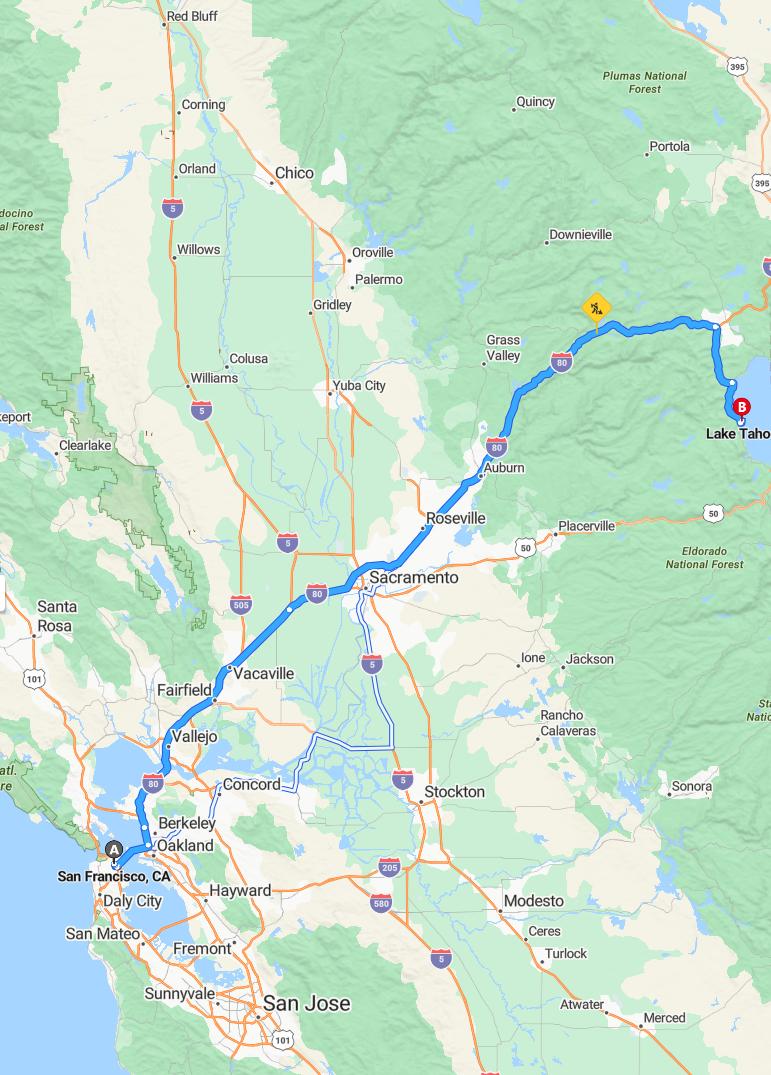Distance and estimated driving time
The drive from San Francisco to Lake Tahoe covers approximately 209 miles via I-80 E and CA-89. The estimated travel time is around 3 hours and 21 minutes, providing a scenic and relatively quick route. This journey offers beautiful landscapes as you ascend into the Sierra Nevada mountains. Be sure to check current road conditions and weather forecasts for a smooth trip.
Driving route
Embarking on a scenic drive from San Francisco to Lake Tahoe offers a delightful journey through diverse Californian landscapes. Starting in San Francisco, you'll pass through Vallejo, known for its waterfront, before heading to Fairfield and Vacaville, charming cities with unique attractions. Continuing northward, Sacramento, the state capital, provides a blend of history and vibrant city life. As you ascend into the Sierra Nevada, Auburn and Grass Valley showcase historic gold rush sites and picturesque mountain scenery, culminating in the stunning outdoor beauty of Lake Tahoe. This route combines urban experiences with natural splendor, making for an enriching and memorable road trip.

Best time to travel
The best time to drive from San Francisco to Lake Tahoe is during the late spring and early fall, when the weather is typically mild and the roads are less crowded. Traveling between May and June or September and October offers pleasant temperatures and clearer road conditions, making for a more comfortable journey. Summer months can be busy due to tourism, especially around popular stops like Sacramento and Lake Tahoe, leading to potential traffic delays. Winter travel is possible but may require snow chains and caution due to winter weather, so early planning is essential during the colder months.
Weather conditions and seasonal considerations
When driving from San Francisco to Lake Tahoe, weather conditions and seasonal considerations play a crucial role in planning your trip. During winter months, snow and icy roads in the Sierra Nevada can cause delays and road closures, requiring chains or four-wheel drive vehicles for safety. Spring and fall may bring unpredictable weather, including rain and fog, particularly in the Vallejo, Fairfield, and Sacramento areas. Summer offers clearer skies and warmer temperatures, but high traffic volumes around holidays can lead to congestion, especially near Auburn and Grass Valley, so travelers should plan accordingly.
Road conditions and closures
Travelers heading from San Francisco to Lake Tahoe should stay informed about current road conditions and potential closures along the route. Typically, the journey involves passing through Vallejo, Fairfield, Vacaville, Sacramento, Auburn, and Grass Valley before reaching Lake Tahoe, with each segment subject to seasonal weather impacts. During winter months, chains or snow tires may be required, and occasional snow or ice can lead to temporary closures or delays, especially on mountain passes. It is advisable to check real-time traffic updates and road status from Caltrans or local transportation agencies before starting the trip to ensure a safe and smooth journey.
Scenic stops and points of interest
As you drive from San Francisco to Lake Tahoe, you can enjoy several scenic stops and points of interest along the way. In Vallejo and Fairfield, explore downtown districts and local parks that offer picturesque settings and opportunities for short walks. Continuing through Vacaville and Sacramento, visit historic sites, vibrant downtown areas, and scenic riverside parks that highlight California's diverse landscapes. As you approach Lake Tahoe via Auburn and Grass Valley, take in the lush forests and mountain views that make this route especially breathtaking for nature lovers.
Travel safety tips and precautions
When driving from San Francisco to Lake Tahoe, it's important to prioritize safety by staying alert and avoiding distractions while on the road. Be sure to check your vehicle's condition beforehand, including tire pressure and fluid levels, to prevent breakdowns. Keep an emergency kit, warm blankets, and water in your car, especially as you approach higher elevations like Auburn and Grass Valley, where weather conditions can change rapidly. Finally, plan for regular breaks at towns like Vacaville and Sacramento to rest and stay refreshed, ensuring a safe and enjoyable journey to Lake Tahoe.
Parking options at Lake Tahoe
Lake Tahoe offers a variety of parking options for visitors, including designated day-use parking lots at popular beaches and recreation areas such as Sand Harbor and Kings Beach. Many of these lots operate on a first-come, first-served basis and require a parking fee, especially during peak seasons. Additionally, some areas provide parking permits for extended stays or access to specific trailheads and viewpoints. Visitors should plan ahead and consider using public transportation or shuttle services when possible, to reduce congestion and ensure a more enjoyable experience at the stunning lake.
Nearby amenities and services
As you drive from San Francisco to Lake Tahoe, you'll pass through several cities offering a variety of amenities and services. Vallejo and Fairfield provide shopping centers, restaurants, and gas stations to ensure your convenience. Vacaville and Sacramento are larger urban areas with numerous hotels, medical facilities, entertainment options, and outdoor recreational stores. Closer to Lake Tahoe, towns like Auburn and Grass Valley feature charming boutiques, local eateries, and outdoor activity centers, making your journey both comfortable and enjoyable.
Alternative routes and detours
When driving from San Francisco to Lake Tahoe, travelers can consider alternative routes such as taking I-80 East directly through Vallejo and Sacramento for a faster trip. For scenic detours, exploring the alternative road via Highway 49 through Nevada City and Grass Valley offers a more picturesque experience, albeit with longer travel times. Seasonal conditions, like snow in winter, may require switching to snow chains or choosing different roads, such as connecting through Truckee via Highway 267. It's advisable to monitor road conditions and traffic updates before departure to ensure a safe and efficient journey, especially during inclement weather or peak travel periods.
